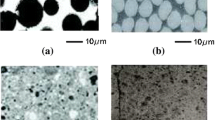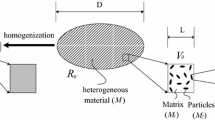Abstract
Mechanical behaviour of particle composite materials is growing of interest to engineering applications. A computational homogenization procedure in conjunction with a statistical approach have been successfully adopted for the definition of the representative volume element (RVE) size, that in random media is an unknown of the problem, and of the related equivalent elastic moduli. Drawback of such a statistical approach to homogenization is the high computational cost, which prevents the possibility to perform series of parametric analyses. In this work, we propose a so-called fast statistical homogenization procedure (FSHP) developed within an integrated framework that automates all the steps to perform. Furthermore within the FSHP, we adopt the numerical framework of the virtual element method for numerical simulations to reduce the computational burden. The computational strategies and the discretization adopted allow us to efficiently solve the series (hundreds) of simulations and to rapidly converge to the RVE size detection.













Similar content being viewed by others
References
Anthoine A (1995) Derivation of the in-plane elastic characteristics of masonry through homogenization theory. Int J Solids Struct 32(2):137–163
Artioli E, Beirão Da Veiga L, Lovadina C, Sacco E (2017) Arbitrary order 2D virtual elements for polygonal meshes: Part I, elastic problem. Comput Mech 60(3):355–377
Beirão Da Veiga L, Brezzi F, Cangiani A, Manzini G, Marini LD, Russo A (2013) Basic principle of virtual element methods. Math Models Methods Appl Sci 23(01):199–214
Beirão Da Veiga L, Brezzi F, Marini L (2013) Virtual elements for linear elasticity problems. SIAM J Numer Anal 51(2):794–812
Beirão Da Veiga L, Brezzi F, Marini LD, Russo A (2014) The Hitchhiker’s guide to the virtual element method. Math Models Methods Appl Sci 24(08):1541–1573
Bouaoune L, Brunet Y, Moumen AE, Kanit T, Mazouz H (2016) Random versus periodic microstructures for elasticity of fibers reinforced composites. Compos Part B Eng 103:68–73
Bouyge F, Jasiuk I, Ostoja-Starzewski M (2001) Micromechanically based couple-stress model of an elastic two-phase composite. Int J Solids Struct 38(10–13):1721–1735
Capecchi D, Ruta G, Trovalusci P (2011) Voigt and poincaré’s mechanistic–energetic approaches to linear elasticity and suggestions for multiscale modelling. Arch Appl Mech 81(11):1573–1584
Cecchi A, Sab K (2002) A multi-parameter homogeneization study for modelling elastic masonry. Eur J Mech A/Solids 21:249–268
De Bellis ML, Wriggers P, Hudobivnik B, Zavarise G (2018) Virtual element formulation for isotropic damage. Finite Elem Anal Des 144:38–48
Djebara Y, Moumen AE, Kanit T, Madani S, Imad A (2016) Modeling of the effect of particles size, particles distribution and particles number on mechanical properties of polymer-clay nano-composites: numerical homogenization versus experimental results. Compos Part B Eng 86:135–142
Du X, Ostoja-Starzewski M (2006) On the size of representative volume element for darcy law in random media. Proc R Soc Lond A Math Phys Eng Sci 462(2074):2949–2963
Filipovic N (2016) Modeling the behavior of smart composite materials. In: Montemor M (ed) Smart composite coatings and membranes, Woodhead publishing series in composites science and engineering. Woodhead, Sawston, pp 61–82 (Chap. 3)
Forest S, Sab K (1998) Cosserat overall modeling of heterogeneous materials. Mech Res Commun 25(4):449–454
Ghosh S, Kubair DV (2016) Exterior statistics based boundary conditions for representative volume elements of elastic composites. J Mech Phys Solids 95:1–24
Gitman IM, Askes H, Sluys LJ (2007) Representative volume: existence and size determination. Eng Fract Mech 74(16):2518–2534
Hill R (1963) Elastic properties of reinforced solids: some theoretical principles. J Mech Phys Solids 11(5):357–372
Kanit T, Forest S, Galliet I, Mounoury V, Jeulin D (2003) Determination of the size of the representative volume element for random composites: statistical and numerical approach. Int J Solids Struct 40(13–14):3647–3679
Khisaeva ZF, Ostoja-Starzewski M (2006) On the size of rve in finite elasticity of random composites. J Elast 85(2):153
Kubair D, Pinz M, Kollins K, Przybyla C, Ghosh S (2018) Role of exterior statistics-based boundary conditions for property-based statistically equivalent representative volume elements of polydispersed elastic composites. J Compos Mater 52(21):2919–2928
Lourenço PB, Milani G, Tralli A, Zucchini A (2007) Analysis of masonry structures: review of and recent trends in homogenization techniques. Can J Civ Eng 34(11):1443–1457
Matsuda T, Ohno N, Tanaka H, Shimizu T (2003) Effects of fiber distribution on elastic–viscoplastic behavior of long fiber-reinforced laminates. Int J Mech Sci 45(10):1583–1598 (6th Asia-Pacific symposium on advances in engineering plasticity and its applications)
Ostoja-Starzewski M (1998) Random field models of heterogeneous materials. Int J Solids Struct 35(19):2429–2455
Ostoja-Starzewski M (2006) Material spatial randomness: from statistical to representative volume element. Probab Eng Mech 21:112–132
Ostoja-Starzewski M (2007) Microstructural randomness and scaling in mechanics of materials. CRC Press, Boca Raton
Ranganathan SI, Ostoja-Starzewski M (2008) Scaling function, anisotropy and the size of RVE in elastic random polycrystals. J Mech Phys Solids 56:2773–2791
Ranganathan SI, Ostoja-Starzewski M (2009) Towards scaling laws in random polycrystals. Int J Eng Sci 47(11):1322–1330 (“Mechanics, Mathematics and Materials” a Special Issue in memory of A.J.M. Spencer FRS)
Reccia E, De Bellis ML, Trovalusci P, Masiani R (2018) Sensitivity to material contrast in homogenization of random particle composites as micropolar continua. Compos Part B Eng 136:39–45
Sab K, Nedjar B (2005) Periodization of random media and representative volume element size for linear composites. C R Mec 333(2):187–195
Sadowski T, Marsavina L (2011) Multiscale modelling of two-phase ceramic matrix composites. Comput Mater Sci 50(4):1336–1346
Sadowski T, Pankowski B (2016) Numerical modelling of two-phase ceramic composite response under uniaxial loading. Compos Struct 143:388–394
Salmi M, Auslender F, Bornert M, Fogli M (2012) Apparent and effective mechanical properties of linear matrix-inclusion random composites: improved bounds for the effective behavior. Int J Solids Struct 49(10):1195–1211
Sansalone V, Trovalusci P, Cleri F (2006) Multiscale modelling of materials by a multifield approach: microscopic stress and strain distribution in fiber-matrix composites. Acta Mater 54(13):3485–3492
Shewchuk JR (2002) Delaunay refinement algorithms for triangular mesh generation. Comput Geom 22(1):21–74 (16th ACM symposium on computational geometry)
Stefanou I, Sulem J, Vardoulakis I (2008) Three-dimensional Cosserat homogenization of masonry structures: elasticity. Acta Geotech 3:71–83
Trovalusci P, Augusti G (1998) A continuum model with microstructure for materials with flaws and inclusions. J Phys IV Pr8:383–390
Trovalusci P, De Bellis ML, Ostoja-Starzewski M, Murrali A (2014) Particulate random composites homogenized as micropolar materials. Meccanica 49(11):2719–2727
Trovalusci P, Ostoja-Starzewski M, De Bellis ML, Murrali A (2015) Scale-dependent homogenization of random composites as micropolar continua. Eur J Mech A/Solids 49:396–407
Trovalusci P, De Bellis ML, Ostoja-Starzewski M (2016) A statistically-based homogenization approach for particle random composites as micropolar continua. Adv Struct Mater 42:425–441
Trovalusci P, De Bellis ML, Masiani R (2017) A multiscale description of particle composites: from lattice microstructures to micropolar continua. Compos Part B Eng 128:164–173
Wriggers P, Rust WT, Reddy BD (2016) A virtual element method for contact. Comput Mech 58(6):1039–1050
Wriggers P, Reddy BD, Rust W, Hudobivnik B (2017) Efficient virtual element formulations for compressible and incompressible finite deformations. Comput Mech 60(2):253–268
Zeman J, Sejnoha M (2007) From random microstructures to representative volume elements. Model Simul Mater Sci Eng 15(4):S325–S335
Funding
This work is supported by Italian Ministry of University and Research—P.R.I.N. 2015, Sapienza Research Unit, under Grant B86J16002300001, Project 2015JW9NJT “Advanced mechanical modeling of new materials and structures for the solution of 2020 Horizon challenges—and by Sapienza—University Grant 2016, B82F16005920005, and University Grant 2017, B83C17001440005.
Author information
Authors and Affiliations
Corresponding author
Additional information
Publisher's Note
Springer Nature remains neutral with regard to jurisdictional claims in published maps and institutional affiliations.
Rights and permissions
About this article
Cite this article
Pingaro, M., Reccia, E., Trovalusci, P. et al. Fast statistical homogenization procedure (FSHP) for particle random composites using virtual element method. Comput Mech 64, 197–210 (2019). https://doi.org/10.1007/s00466-018-1665-7
Received:
Accepted:
Published:
Issue Date:
DOI: https://doi.org/10.1007/s00466-018-1665-7




